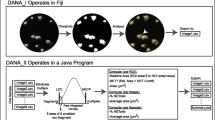Abstract
The aim of this study was to determine the structural–morphological differences between rapid and classic netosis of human neutrophils. A method for studying the netosis process using lattices for transmission electron microscopy has been developed. Dynamics of blood neutrophil netosis and differences in the cell death processes induced by ionomycin and opsonized bacteria Staphylococcus aureus were studied with flow cytometry. Morphological features of rapid and classic netosis were examined with methods of scanning electron, fluorescence, and light microscopy. The structural and morphological similarities and differences between the two variants of netosis induced by opsonized S. aureus were described. It was revealed that classical netosis can induce the formation of extracellular traps in neighboring neutrophils. It was shown that the morphological features of extracellular traps can be used to differentially diagnose the development of rapid and classical netosis not only with high-resolution microscopy, but also with traditional light microscopy.





Similar content being viewed by others
REFERENCES
Barnado, A., Crofford, L.J., and Oates, J.C., Neutrophil extracellular traps (NETs) as targets for biomarkers and therapies in autoimmune diseases, J. Leukocyte Biol., 2016, vol. 99, no. 2, pp. 265–278. https://doi.org/10.1189/jlb.5BT0615-234R
Brinkmann, V. and Zychlinsky, A., Neutrophil extracellular traps: is immunity the second function of chromatin?, J. Cell Biol., 2012, vol. 198, pp. 773–783. https://doi.org/10.1083/jcb.201203170
Brinkmann, V., Reichard, U., Goosmann, C., Fauler, B., Uhlemann, Y., Weiss, D.S., Weinrauch, Y., and Zychlinsky, A., Neutrophil extracellular traps kill bacteria, Science, 2004, vol. 303, pp. 1532–1535. https://doi.org/10.1126/science.1092385
Dąbrowska, D., Jabłońska, E., Garley, M., Ratajczak-Wrona, W., and Iwaniuk, A., New aspects of the biology of neutrophil extracellular traps, Scand. J. Immunol., 2016, vol. 84, pp. 317–322. https://doi.org/10.1111/sji.12494
Fuchs, T.A., Abed, U., Goosmann, C., Hurwitz, R., Schulze, I., Wahn, V., Weinrauch, Y., Brinkmann, V., and Zychlinsky, A., Novel cell death program leads to neutrophil extracellular traps, J. Cell Biol., 2007, vol. 176, pp. 231–241. https://doi.org/10.1083/jcb.200606027
Galluzzi, L., Vitale, I., Aaronson, S.A., Abrams, J.M., et al., Molecular mechanisms of cell death: recommendations of the nomenclature committee on cell death, Cell Death Differ., 2018, vol. 25, pp. 486–541. https://doi.org/10.1038/s41418-017-0012-4
Gavillet, M., Martinod, K., Renella, R., et al., Flow cytometric assay for direct quantification of neutrophil extracellular traps in blood samples, Am. J. Hematol., 2015, vol. 90, pp. 1155–1158. https://doi.org/10.1002/ajh.24185
Grayson, P.C. and Kaplan, M.J., Neutrophil extracellular traps (NETs) highlight novel aspects of innate immune system involvement in autoimmune diseases, J. Leukocyte Biol., 2016, vol. 99, pp. 253–264. https://doi.org/10.1189/jlb.5BT0615-247R
Lotosh, N.Yu., Alyaseva, S.O., Vasilov, R.G., and Selischeva, A.A., Stearylamine causes the formation of neutrophil extracellular traps regardless of reactive oxygen species, Cell Tissue Biol., 2019, vol. 13. pp. 366–375 .
Obermayer, A., Stoiber, W., Krautgartner, W.D., Klappacher, M., Kofler, B., Steinbacher, P., Vitkov, L., Grabcanovic-Musija, F., and Studnicka, M., New aspects on the structure of neutrophil extracellular traps from chronic obstructive pulmonary disease and in vitro generation, PLoS One, 2014, vol. 9. e97784. https://doi.org/10.1371/journal.pone.0097784
Pilsczek, F.H., Salina, D., Poon, K.K.H., Fahey, C., Yipp, B.G., Sibley, C.D., Robbins, S.M., Green, F.H.Y., Surette, M.G., Sugai, M., Bowden, M.G., Hussain, M., Zhang, K., and Kubes, P., A novel mechanism of rapid nuclear neutrophil extracellular trap formation in response to Staphylococcus aureus,J. Immunol., 2010, vol. 185, pp. 7413–7425. https://doi.org/10.4049/jimmunol.1000675
Pleskova, S.N., Gorshkova, E.N., and Kriukov, R.N., Dynamics of formation and morphological features of neutrophil extracellular traps formed under the influence of opsonized Staphylococcus aureus,J. Mol. Recognit., 2018, vol. 31. e2707. https://doi.org/10.1002/jmr.2707
Podosinnikov, I.S., Nilova, L.G., Babichenko, I.V., Turina, O.P., and Ponomareva, V.N., Method for determining the chemotactic activity of leukocytes, Lab. Delo, 1981, vol. 8, pp. 468–470.
Yousefi, S., Mihalache, C., Kozlowski, E., Schmid, I., and Simon, H.U., Viable neutrophils release mitochondrial DNA to form neutrophil extracellular traps, Cell Death Differ., 2009, vol. 16, pp. 1438–1444. https://doi.org/10.1038/cdd.2009.96
ACKNOWLEDGMENTS
This study was partially performed on the equipment of the Centers for Collective Use New Materials and Resource-Saving Technologies and Center for Scanning Probe Microscopy. We are sincerely grateful to Prof. V.A. Vodeneev and Associated Professor I.V. Balalaeva for their help in fluorescence experiments.
Funding
This study was supported by the Russian Science Foundation, project no. 16-14-10179.
Author information
Authors and Affiliations
Corresponding author
Ethics declarations
Conflict of interests. The authors declare that they have no conflict of interest.
Statement of compliance with standards of research involving humans as subjects. All procedures involving human beings met the ethical standards of the Bioethics Commission of Lobachevsky Nizhny Novgorod National Research State University and the Helsinki Declaration of 1964 and its subsequent emendations. Informed voluntary consent was obtained from each of the participants.
Additional information
Translated by I. Fridlyanskaya
Abbreviations: AFM—atomic force microscopy, ROS—reactive oxygen species, BSA—bovine serum albumin, PBS—physiological buffered saline, MPO—myeloperoxidase, NG—neutrophil granulocyte, TEM—transmission electron microscopy, SEM—scanning electron microscopy, NET—neutrophil extracellular trap.
Rights and permissions
About this article
Cite this article
Pleskova, S.N., Gorshkova, E.N., Boryakov, A.V. et al. Morphological Characteristics of Rapid and Classical Netosis. Cell Tiss. Biol. 14, 28–35 (2020). https://doi.org/10.1134/S1990519X20010083
Received:
Revised:
Accepted:
Published:
Issue Date:
DOI: https://doi.org/10.1134/S1990519X20010083




